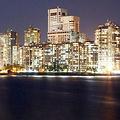 為因應全球80%最大的城市都位於鄰近河流或海洋區域,並且暴露在洪泛、海平面上升以及颶風的氣候危機之下,聯合國世界銀行8月6日出版報告,提供這些人口集中區域如何對抗全球暖化效應的建議。
為因應全球80%最大的城市都位於鄰近河流或海洋區域,並且暴露在洪泛、海平面上升以及颶風的氣候危機之下,聯合國世界銀行8月6日出版報告,提供這些人口集中區域如何對抗全球暖化效應的建議。
這本名為「抵禦氣候變化城市(Climate Resilient Cities)」的報告是要作為東亞及太平洋地區控制氣候變遷所造成的傷害並強化災難危機管理的初步指引,以面對地球升溫後所預期頻繁且極端的氣象事件。這個區域的世界銀行首席環境專家普瑞沙德(Neeraj Prasad)表示:「最後,受到氣候變遷衝擊最大的一些城市將會是那些準備最不周詳的」。
這個報告是由「聯合國災害縮減國際策略組織(UN International Strategy for Disaster Reduction)」、世界銀行及其所屬的「減災及災後重建署(Global Facility for Disaster Reduction and Recovery)」聯合製作的,報告中緊急呼籲主管當局要及早保護他們的城市。
擁有大約1360萬人口的印度金融首都孟買(Mumbai,原名Bombay)是全世界最大的城市。孟買位於印度的阿拉伯海沿岸的奧哈斯河(Ulhas River)河口,根據2007年聯合國國際環境與開發研究所(International Institute for Environment and Development,IIED)所發表的研究結果,她是最容易受全球暖化危害的城市之一。孟買與東京、紐約、上海、雅加達及達卡同在危機城市之列,這些城市都有數以百萬人民處在強烈風暴及洪泛的危機之下。
災害縮減國際策略組織主任布里斯諾(Salvano Briceño)表示:「已經有90%的災難是與天氣相關的,氣候變遷跨政府專家小組也預測會有更強更頻繁的颶風及洪泛。我們不能再等待了,我們已經有降低氣候相關危機衝擊的工具,現在需要用到它們了」。
布里斯諾指出,2005年在日本兵庫縣被168個政府所採納的「兵庫行動綱領(Hyogo Framework for Action)」可以作為降低災難衝擊的工具,綱領中提供務實且有效能的防災方法,以應付包括極端氣候事件所導致的災難。
所謂有效能的方法包括不在氾濫平原或是鄰近海岸地區建築屋舍,反之,應該在地勢較高的地方採用耐受性高的材料建築,以承受風力及水壓。
此外,還要保護學校、醫院及馬路等關鍵基礎設施,建立預警系統,同時為必須要撤離的民眾建立避難處所。這些都是「兵庫行動綱領」所涵蓋的基本方式。布里斯諾緊急呼籲各國政府要為因應氣候變遷開始籌募足夠的經費,因為有許多弱勢的國家將無法用他們自己的國家預算來支應度過難關的費用。
With eight of the world’s 10 largest cities located near rivers or seas and exposed to such climate hazards as flooding, sea level rise, and hurricanes, a United Nations-World Bank report released today offers advice on how to make these population centers more resistant to the effects of global warming.
"Climate Resilient Cities" is intended as a primer for East Asia and the Pacific to curb vulnerability to climate change and strengthen disaster risk management in the face of the frequent and extreme weather events expected as the planet's temperature climbs.
"Ultimately, the cities hardest hit by climate change will be the ones least prepared," said Neeraj Prasad, the World Bank’s lead environmental specialist for the region.
Jointly produced by the UN International Strategy for Disaster Reduction, the World Bank and its Global Facility for Disaster Reduction and Recovery, the report urges managers to protect their cities sooner rather than later.
With an estimated population of 13.6 million, India's financial capital Mumbai, formerly Bombay, is the world's largest city.
Located at the mouth of Ulhas River on India's Arabian Sea coast, Mumbai is among the cities most vulnerable to global warming and rising sea levels, says a 2007 study published by the Institute for Environment and Development.
Mumbai was listed along with Tokyo, New York, Shanghai, Jakarta and Dhaka as cities where millions are at risk of heavy storms and flooding.
"Ninety percent of disasters are already weather-related, and more intense and frequent hurricanes and floods are predicted by the Intergovernmental Panel on Climate Change,” says Salvano Briceño, director of the International Strategy for Disaster Reduction. "We cannot wait. We already have the tools to reduce the impact of climate-related hazards and we need to use them now."
Briceño points to the Hyogo Framework for Action adopted by 168 governments in Hyogo, Japan in 2005 as a tool that offers practical and efficient measures to reduce the impact of disasters, including extreme climate events.
These measures include not building houses in floodplains or close to coastal areas and instead building on higher ground with resilient materials able to sustain the force of winds and water pressure.
Protecting critical infrastructures such as schools, hospitals and roads; and building early warning systems and shelters for people who must evacuate are some of the common sense measures included in the Hyogo Framework.
Briceño urged governments to start sourcing adequate funds for adaptation to climate change, as many vulnerable countries will be unable to pay for adaptation out of their own budgets.
全文及圖片詳見:ENS







